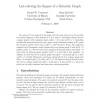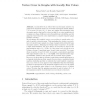11 search results - page 2 / 3 » Total chromatic number of planar graphs with maximum degree ... |
DM
2010
13 years 5 months ago
2010
Let Mad(G) denote the maximum average degree (over all subgraphs) of G and let i(G) denote the injective chromatic number of G. We prove that if Mad(G) 5 2 , then i(G) + 1; sim...
JGT
2008
13 years 5 months ago
2008
The square G2 of a graph G is the graph with the same vertex set as G and with two vertices adjacent if their distance in G is at most 2. Thomassen showed that for a planar graph ...
COCOON
2005
Springer
13 years 11 months ago
2005
Springer
We consider the problem of finding a balanced ordering of the vertices of a graph. More precisely, we want to minimise the sum, taken over all vertices v, of the difference betwe...
STOC
1990
ACM
13 years 9 months ago
1990
ACM
ions (Extended Abstract) Noga Alon Paul Seymour Robin Thomas Let G be an n-vertex graph with nonnegative weights whose sum is 1 assigned to its vertices, and with no minor isomorp...
ICALP
2011
Springer
12 years 9 months ago
2011
Springer
In [13], Erd˝os et al. defined the local chromatic number of a graph as the minimum number of colors that must appear within distance 1 of a vertex. For any ∆ ≥ 2, there are ...


